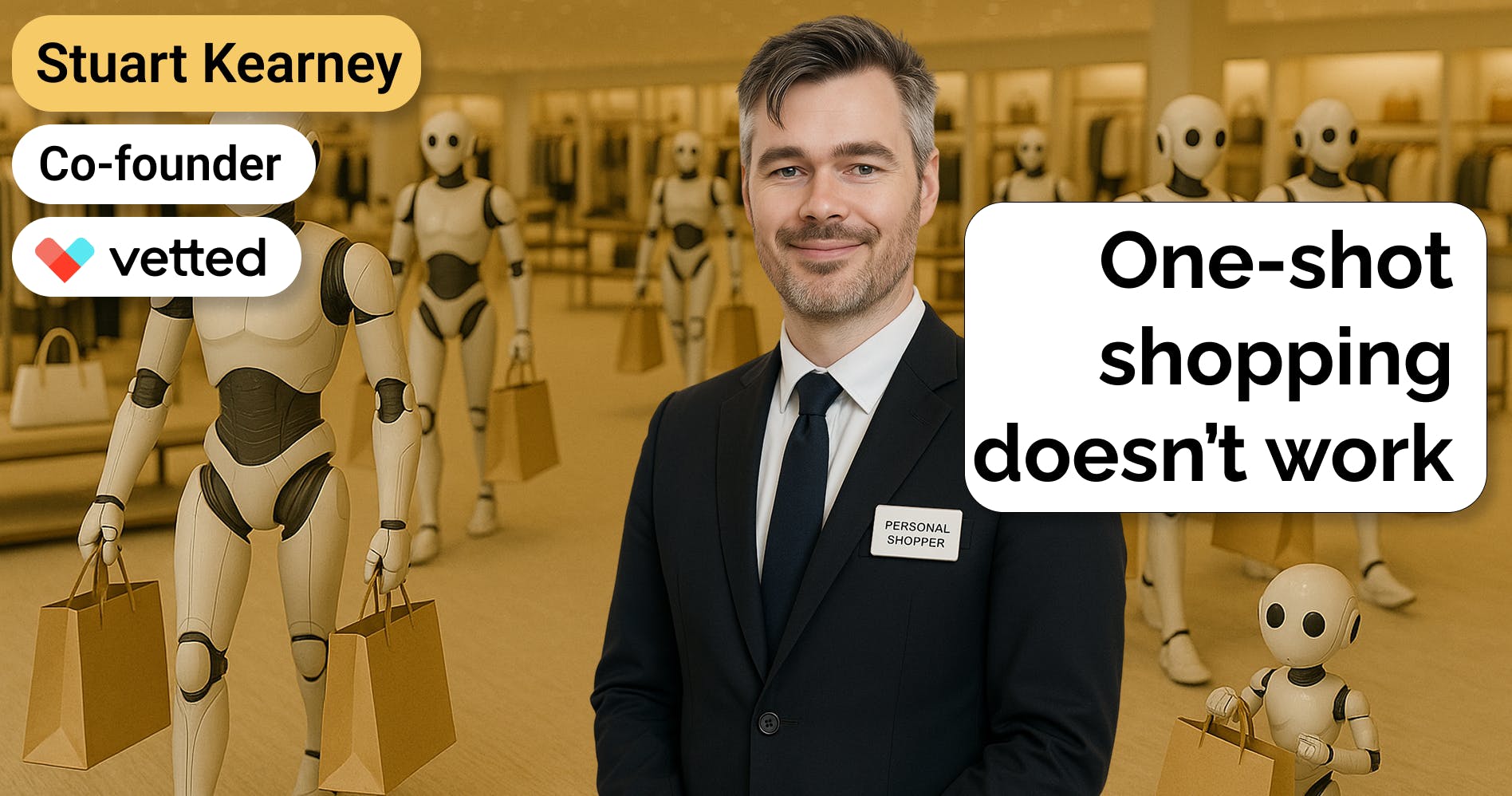Tyler Scriven, CEO of Saltbox, on co-warehousing and D2C ecommerce
 Jan-Erik Asplund
Jan-Erik Asplund

Background
Tyler Scriven is the co-founder and CEO at Saltbox. We talked to Tyler about the growth of D2C ecommerce, why D2C ecommerce fits the business model of co-warehousing, and what the next wave of ecommerce businesses need to succeed.
Questions
- Can you give us an introduction to Saltbox and tell us a little about the impetus for starting the company?
- 2020-2022 has obviously been an interesting time for ecommerce and D2C businesses. Can you talk a bit about what you’ve seen over the last few years when it comes to your customer base?
- One thing that'd be really interesting to hear more about is what some of the increasing sophistication looks like. What have you seen companies specifically doing as they've been forced to figure out this logistics problem?
- Can you talk a bit about the potential competition with Shopify which has the Shopify Fulfillment Network and interfaces between brands the many third-party logistics companies out there that offer their own warehousing and shipping services? Is there a dynamic here around businesses wanting to keep more of their stack “in-house”?
- Can you talk about the kinds of customers, and the kinds of companies that are at the Saltboxes today?
- Can you walk us through the cost breakdown of what it looks like for an ecommerce brand to work out of a Saltbox space vs. roughly what it costs to rent out their own separate space for shipping products and use a service like X for fulfillment/etc? Is Saltbox’s primary value proposition that it’s cheaper than putting that stack together yourself or is it more about convenience?
- How do you think about expansion and where to put a new Saltbox location?
- How do you think about potentially serving businesses past that natural graduation point where they might leave Saltbox to get their own warehouse spaces? How does Saltbox scale there?
Interview
Can you give us an introduction to Saltbox and tell us a little about the impetus for starting the company?
The genesis of Saltbox is that in 2016, pursuing an interest I'd had in SMB ecommerce, I decided to buy a CPG retail brand. At the time, the company's revenue was 95-plus percent retail driven, and I saw a big opportunity to expand its ecommerce business, so we set off to pursue that. We were successful in doing so, and grew the business well, but what I learned in the process was that the logistics and physical operations of an SMB ecommerce company are very, very painful. On the one hand, we had great digitally enabling technology to help power our go-to market customer relationships—think about things like Shopify, Stripe, Facebook, MailChimp, this broad ecosystem of digital-enabling technologies—but we were really struggling with even the most basic aspects of our logistics and physical operations. That dichotomy really struck me.
The reason it struck me was because I recognized, even then, that our economy was increasingly becoming a logistically driven economy. More and more, all commerce is becoming logistically driven and logistics is an inherently complex and capital-intensive activity, which is akin to kryptonite for a small business. These are two things that they need to very carefully avoid, and yet two things which they are directly confronted with as they think about how to achieve a level of logistical sophistication to be competitive in the marketplace.
It became clear that there was a big problem there. I would go so far to say potentially an existential problem as it relates to the small business, because the trajectory of logistical sophistication in the market at large is increasing quite rapidly. But again, as it increases, so too does the complexity and the capital intensity, and that is making it harder and harder and harder for these companies to remain competitive. I felt it would be critical to solve this problem or else.
When we talk about being logistically enabled, what does that mean? Our thinking here starts with developing a picture of the logistics life cycle within a company. We think of that logistics life cycle, all the activities, the logistics-based activities that occur within the process of selling a good to a customer. That process begins, in our view, at the point at which a merchant converts cash into inventory, and that process ends when they again convert inventory back into cash. All of the things that occur within that lifecycle or within those two windows, we consider to be the logistics lifecycle. You can imagine things such as the sourcing of goods, the importation of goods, warehousing and eventual fulfillment of goods, and capital, too, is an important aspect of that, because in some senses, capital serves as the foundation of one's ability to conduct that process.
So, I would explain to you our approach to solving this problem with that basis established in two ways. One, is about the scope of the solution, the period of time in which we want to solve the problem, and the other is that the solution stack. If we look first at the stack, there are four components: Software, services, infrastructure and capital. Specifically, as I refer to software, I'm referring to logistics-based software that plays important roles in various parts of that lifecycle. You can think of things like shipping management, solutions, or fulfillment management applications. As we talk about services, we are referring primarily to labor-based activities including fulfillment. As we talk about physical infrastructure, we are referring primarily to our physical warehouses. A warehouse is a critical input to logistics activity. And then capital, we're referring specifically to capital that supports inventory, inventory working capital. We think that these four things represent the four pillars of a successful logistics operation.
Then, the other concept that I would introduce is, again this more temporal concept—one of your questions was ‘when do you want to start with the customer?’ The answer is—at a high level, and we can dig into this—we want to service them from the very beginning of their journey to a stage of relative maturity. I won't put a number on that today, but let's just say that it is well past a point of $10 million-plus in revenue. We want to build the solutions that can enable that customer to be competitive and logistically sophisticated through that period of time.
2020-2022 has obviously been an interesting time for ecommerce and D2C businesses. Can you talk a bit about what you’ve seen over the last few years when it comes to your customer base?
We've had an interesting view upon all this. We opened our first Saltbox facility in December of 2019, and of course, a few months later found ourselves in the midst of the pandemic. To be honest, in those earliest days, we questioned whether or not we would be able to remain open. We weren’t sure if we met the criteria of an essential business and such, but it became clear very, very quickly that we did, or at the very least, it became clear that our customers had determined that we did, because, within a matter of two months or so that first facility was entirely sold out.
So, if I zoom out and just ask the question of what we've seen over the past couple of years here, obviously, we've seen what may be considered to be a significant acceleration of ecommerce growth over the past few years, and I believe that is true. The real lasting impact of that, actually, will be an acceleration of the degree of sophistication in the ecommerce logistics ecosystem. Companies were forced to figure these things out much faster than they would've been able to otherwise.
That’s a great thing for our economy at large, because it really forced the creation of additional capacity, it forced the refinement of the systems and processes which support more scaled ecommerce activity. And frankly, it forced a lot of companies to be more deeply engaged in this aspect of their business, which had been, if not neglected, certainly not given as much attention as the go-to-market aspects that had been—and that’s good. We've seen, of course, very steady growth over the past two and a half years here.
One thing that'd be really interesting to hear more about is what some of the increasing sophistication looks like. What have you seen companies specifically doing as they've been forced to figure out this logistics problem?
The simple observation, it's self-serving, obviously, is to find a company like Saltbox. The first solution to one's problem is technology. You have a problem and maybe you don't know how to fix it yourself—this is a good example of that. Let’s take that as an opportunity to zoom in on the day-to-day experience of the Saltbox customer. Here’s a website of a Saltbox customer company called PWR WMN (Power Women). They sell women’s blazers. Like so many modern ecommerce companies, it looks very familiar in its modernity, and one assumes that when they go and press this buy button, that, behind the scenes, there's some really elegant and well-streamed operation taking place. It ends, gets that product to their door.
But the reality is that this is actually that merchant, this woman in the photograph, her name is Kimberly and this was her prior to Saltbox: She's covered in packages with a baby in her arm and she's converted her spare bedroom, or whatever it is, into this makeshift warehouse operation in the course of running her roughly half-million-dollar-a-year business. She's about to head over to the UPS store, and then the FedEx store, and then the post office.
Again, it’s that dichotomy that you can very clearly see here, it’s quite stark. Here’s another example of a company that was operating out of a self-storage facility in pretty challenging conditions. If you look at Kimberly, she came to Saltbox during the pandemic. She was experiencing significant growth, and she realized that what she was doing was not no longer working for her, and now her life is quite a bit simpler. I'm happy to talk in more detail about what's happening, but the big shift, at least for our customer, is a recognition that ‘I cannot neglect this aspect of my business, that success in ecommerce is not just about selling. It is also, perhaps more so, about the operational efficiency with which I can get my products to my customer.’
A lot of small businesses, even still to this day, don't fully appreciate that. Yet, if you look at ecommerce from the lens of someone like Amazon, the most sophisticated of companies, that clearly is deeply built into their DNA. That is, logistics at large, is the defining characteristic of their business. It's that recognition for the SMB that is really critical like, ‘I must be good at this. And then if I'm not over time, my competitive attributes are diminished.’
Can you talk a bit about the potential competition with Shopify which has the Shopify Fulfillment Network and interfaces between brands the many third-party logistics companies out there that offer their own warehousing and shipping services? Is there a dynamic here around businesses wanting to keep more of their stack “in-house”?
There are few ways you can approach it. Taking this simple small ecommerce merchant example first, the reality is that for a business of that size, if you just start first with the warehousing component, there really aren't great options in the marketplace today. It turns out if you're trying to find a less than 10,000-square foot warehouse, it's very, very difficult. They, by and large, don't exist in the marketplace. What this means is that you're forced into some sub-optimal space, whether that's your garage, or basement, or spare bedroom, or whether that's a self-storage facility, or whether that is some one-off arrangement to sublease the corner of someone else's warehouse.
All these things exist, but they're all sub-optimal solutions. That's just addressing the physical space component. Even if you were to find yourself in that, or if you were to magically find a 2,000-square foot warehouse somewhere, you would still have a very hard time getting the carriers to show up there every day, on time, and on schedule, and with the right equipment. And your life is fundamentally more complicated because now, as a half-million-dollar-a-year small business, you now have a warehouse lease and you've got to deal with all the issues that come with that. Again, it's more complexity in a world where you need less.
Another thing to consider again here, just sticking with this simple use case is labor. So we think of warehousing and labor as these two foundational inputs to logistics activity. Oftentimes, you could imagine that the labor needs of a company at that size are inconsistent, or variable, and because of that variability, they’re often forced into making suboptimal decisions, as it relates to labor. For example, they don't have anyone when they need someone, or they have way more support than they need. By providing this integrated on-demand labor solution, we’re bringing operational flexibility to this other critical input, which is labor.
Now that merchant can have exactly what they need, when they need it, and not only can they have what they need, but they can also have it through the modality of a highly trained and trusted source, which is Saltbox’s elastic workforce. One of the things that we are building from a software standpoint, is effectively an application to ingest instructions from our merchants and from our customers, about SOPs for different activities. So I'll just zoom out there and give you a bit more context of what I mean. Today, we have hundreds of customers that are engaging our labor force in thousands of different manual workflows. ‘Please package this this way and take this that way and assemble this, so on and so forth.’
Sometimes those are very simple workflows, sometimes they're fairly involved workflows. All of the knowledge around those instructions—and the requisite skills and abilities that are required to execute those instructions, the equipment that's required, the workflows around them—all these things have to be housed somewhere. So we’re effectively building a labor knowledge management platform that allows us to very efficiently ingest instructions from our customers and to turn those into very, very actionable steps that can be executed by our staff, that have the appropriate points of validation and the appropriate feedback loops with the customer and so on and so forth. What that all amounts to is that this customer now has access to enterprise grade labor at the press of a button within this facility.
Another question you brought up that I'll just address here briefly is the competitive market for fulfillment. You mentioned Shopify, there are, of course, numerous other 3PLs in the marketplace, ShipBob and ShipMonk, Deliverr, and literally thousands of others. The fulfillment marketplace, by and large, is a commoditized marketplace in the United States. I recently saw a forecast from FedEx, they estimated that by 2025—you can look this up, yourself, I'll try to send it to you—somewhere between 50 and 100 billion outbound ecommerce shipments in the United States in the year 2025. I probably have accounted for 3,000 in my house already the past year. So there's a lot of them, a whole bunch of them.
The reality is that it requires a huge market of service providers in order to support that activity. Otherwise, if you do the math, it's just not physically feasible for it to be a consolidated marketplace. Where you see differentiation occurring among fulfillment providers is a couple of different facets. One, is a specialization in product type. For instance, we specialize in large scale products, we do furniture, but we don't do widgets because there are skills and equipment and such that becomes very relevant. There are specializations. Another is the size of the company, there are 3PLs that work exclusively with major brands, and there are others that work up and down the chain.
Another, we believe, is the proximity to the customer. Typically, the way that 3PLs function, is that a typical 3PL is a large, quarter-million square foot building in the middle of some industrial park in the middle of Texas. It's out of the way. It's out of reach, so to say, and the customer is sending their goods into this facility because the 3PL, it has such volume and so many customers, the merchant is required to follow very specific guidelines for everything, even down to the way in which they package those goods to be sent into the facility.
And, as a general matter, the typical 3PL requires a very rigid and defined relationship. Because their business is about scale. It's about volume and throughput and they require precision in the interface between the merchant and themselves in order to keep everything in line. And that makes sense and is to be expected. We think though, that the SMB has a very different need. They don't deal well with complexity, or the requirement to conform in rigid ways to a complex operation. They are for the most part, fairly hectic organizations, they're small and they're nimble and so on and so forth.
We think, then, that you have to relate to them in a fundamentally different way. This is why our approach to fulfillment looks quite different. Instead of having the customer send these finely palletized goods into facilities that are out of reach, we instead are establishing micro-fulfillment centers which exist in very close proximity to them. You've heard the term micro-fulfillment center before. Typically, when you hear this term, you hear this term in the context of much larger, more sophisticated merchants who want to distribute their inventory across the country or what have you, such that inventory is closer to the consumer and can be delivered faster and cheaper. That’s a very important pursuit.
But when we talk about an MFC, we talk about it in a very different way. We’re referring here not to the proximity that it affords to the end consumer, but rather the proximity that it affords to the merchant themselves. And that if you bring that capability much closer to the merchant, you make it much more accessible to them, much more scaled to their scale, then all of a sudden, it is much easier for them to interface. So if you look at a Saltbox MFC, the significant majority of the customers that use that MFC to ship products out, actually live within a driving radius of the MFC. Such that they can literally drive their products in, they can get to know the operator of that MFC, they often will co-locate within that facility, so on and so forth.
It's all about rethinking the need from the perspective of the merchant and how do we make this something that is hyper approachable, hyper accessible to them, versus being purely optimized for the benefit of the end consumer. Because what we realized is that basically small businesses think and operate like consumers. If you want to engage a long tail in that way, you've got to build solutions that reflect that understanding.
Can you talk about the kinds of customers, and the kinds of companies that are at the Saltboxes today?
There are essentially three major groups of customers that we track at Saltbox today. The first representing 60 percent or so of our customer base are SMB ecommerce merchants. We think of this customer as being a small business, engaged in ecommerce activity that is somewhere between $100,000 and five million of revenue. There are outliers on the upper end of that, but that's typical. This customer is coming to Saltbox at the highest level for logistical enablement. Sometimes, they choose to go down a self-service path, which would mean that they are in a workspace facility. They have a warehouse suite there. Today, they may be leveraging our elastic workforce, they may not be. In other cases, they choose to take an outsource pack, so they are shipping their inventory into a Saltbox MFC and relying upon Saltbox as their fulfillment partner. We will continue to develop new solutions for that customer, who falls in that spectrum of software services, infrastructure and capital.
The next customer that I would highlight, I would describe as a logistically-driven service provider. This is an interesting category. It's not the customer that you think of instinctively when you think of Saltbox, but increasingly it's an important customer in our business. So this is a good example of such a customer, a company called GoLocker. They install and operate these locker systems, mainly in apartment facilities and retail centers and such. Their Saltbox use case is that they are deploying these locker systems across the country, and that calls upon having a distributed network of micro-warehouses, and not in their case, but in many cases, also in labor operations which occur within those warehouses.
So imagine if you’re running a business that—forget what you do, but whatever it is—means that you've got to have a 5,000-square foot micro-distribution hub in 25 cities. Within those distribution hubs you have some simple activity, the activity is that every day, 10 times a day, some vendor comes to that facility to retrieve an item and take it away to be installed wherever it's going. Well, this is a challenge for you, because this means that you now have to go out in the market and find 25 micro-warehouses, which again don't really exist to begin with, but even if they did, you got to go and get the brokers, and you got to sign them up, and you got to have utilities and all these things. You have to manage them all, and it is a level of effort for which there's a very low return on investment. You would rather not do these things. Then, if you introduce the labor requirement, you can't just go out and hire hourly workforce in these 25 locations, you've got to hire managers to oversee this activity and you've probably got to hire regional managers and so on and so forth. This, too, begins to represent a significant operational burden on your business. More and more companies are finding a need for this distributed logistics operation.
A simple example, we don't have any such customers, but a simple example, this would be someone like Gopuff. I would argue that if Saltbox had been inserted a decade ago and we were more mature, that someone like Gopuff would've been a customer of ours instead of doing what they'd done. But we do have customers like this today that are logistically driven businesses who don't want to deal with the logistics. That customer really thinks about Saltbox, I think, in a similar way that others may think about AWS. There's a customer here who thinks about the prospect of the challenge of having to build cloud-computing infrastructure, and they can do it themselves, of course, but they would much rather be able to outsource that activity.
Here's an example, an email from this customer. I think what's interesting is we see a lot of companies now who are basically saying to us ‘hey, our intention is to expand our offerings on the back of your platform. If Saltbox goes to New York, then we're going to New York. Because without Saltbox, it's very challenging to operate in that market.’ What they're getting is a consistent experience. They know that whether you have one or 25 Saltbox facilities, they're all the exact same. They all operate the same, and they all have the same standards, they all have the same staff, and they all have the same labor platform. You get one bill, so on and so forth. That’s hugely valuable to them, and it becomes especially valuable as those companies are able to inject their SOPs.
One other example I think I may have mentioned before is Zuna. This is another company that happens to be in the ecommerce ecosystem. Merchants send them their products, they store, shoot and return those products back to the customer. In their instance, Saltbox is both their physical warehousing provider, but also Saltbox is administering the SOPs behind the scenes to enable that activity. I'll give you just a quick look at what this looks like. Please, this is confidential. What you're seeing here is a written version of an SOP for Zuna. This is a SOP for the process of returning a product back into their warehouse via Saltbox following a photoshoot.
Basically, it's just a collection of very detailed instructions on what to do with those things. An interesting aspect of this is that our staff has to go through a training process and get a certain score before they can administer this SOP. Now again, this is what we're working on migrating into our own proprietary knowledge and labor management solution, but hopefully this brings that idea to life a bit. Imagine you have thousands of these things, true processes you're running in the physical world on behalf of companies, that want those processes to be as efficient as if they gave instructions to some computing platform. They want validation of completion—well, how do you do that? That's what's happening in these facilities. That's where the idea of the AWS of logistics comes into play. It's like ‘don't go and source your own 25 warehouses. Don't go and hire your own laborer and your own management staff and build your own SOP system. Just give it to us and we'll run it for you.’ So you can basically program logistics-based activities in the physical world.
Can you walk us through the cost breakdown of what it looks like for an ecommerce brand to work out of a Saltbox space vs. roughly what it costs to rent out their own separate space for shipping products and use a service like X for fulfillment/etc? Is Saltbox’s primary value proposition that it’s cheaper than putting that stack together yourself or is it more about convenience?
The first thing I would say is that it's fairly rare that we encounter a customer that’s doing that calculation in their head where they're saying ‘well, what is the cost of this activity in a do-it-yourself modality versus at Saltbox?’ The reason for that is because, effectively, the next best alternative, the do-it-yourself alternative, is a really impaired alternative. I'll go back to the simple example of Kimberly: If you're Kimberly, you've given up your spare bedroom. What's the value of that? You tell me, right? You have to drive back and forth to the post office and UPS store every day. What's the cost of that? I don't know. You have to receive palletized freight at your house and your neighbors yell at you all the time, so on and so forth.
There are a lot of really unfortunate situations people find themselves in, which fundamentally just don't work well, and they're comparing that against Saltbox, where all these things work extremely efficiently. It's really a value-based pricing decision that they're making versus a comparative alternative. Now, where you can get into a clearer comparative approach is in looking at the cost of outsourcing fulfillment, whether to us or someone else, versus a self-service mode of fulfillment. If I'm Kimberly, and I'm running a straightforward ecommerce business, and I've got a warehouse and fulfill goods, I can do it myself or I can outsource it.
You could compare those costs. You could say well, what is the pick, pack and ship fee per order? What are the storage fees?’ and you can get a very clear picture of what your costs would be to have a 3PL like Saltbox or someone else do that work for you. The picture, of course, of the self-service mode is less clear from a cost input standpoint. Obviously, you can account for the cost of a warehouse, and materials, and supplies and such, but as it relates to accounting for your time or the overall operational burden, that's a bit different. What we see here is that often entrepreneurs make—I won't call them irrational decisions—but they make diverging decisions that aren’t necessarily driven by the logic of data.
Let me illustrate that. We get lots and lots of companies that come to us and say ‘I'm coming to Saltbox because I want to run my own fulfillment operation.’ We say ‘okay, well why do you want to do that?" They say ‘well, I want to do that because I've tried three different 3PLs and they all suck. They've all failed me. And so I'm just so frustrated that I just want to do it myself now and Saltbox provides the infrastructure to allow for that.’ Then, they come to Saltbox and begin doing it themselves and they're happy for a while. But then, a few months in they realize ‘oh, man, this is actually challenging because this means that every single day, whether it's a holiday or it's my birthday or whatever day it is, I've got to come here and I've got to pick, pack and ship orders and that turns out that's hard and I value my time more than that essentially.’
Then, they conclude that, actually, they want to return back to fulfillment. Oftentimes, they will find that our integrated fulfillment model where that MFC is down the hallway, not across the country, is better because it allows for a much more fluid communication and it's much more approachable in all the ways that we described. So that's reflecting that value proposition again. But, I guess the point is that these companies, in a world where you have a million-plus small businesses, and for that matter, big ones, they make all sorts of choices about how they want to manage their logistics operations. It can be easy to be prescriptive about what’s the best way based on the simple facts, but the reality is that all sorts of factors come into play in the context of these decisions.
One of the things that we have positioned ourselves to be very good at is dealing with the nuances of those decisions and having the right solutions in place at the right times to support that customer, no matter what it could be. If I go back for a minute to the notion of the core building blocks, fulfillment and labor, I would also add capital to that as a third. But we can use those building blocks to create differing levels of product high solutions. On the one hand, we can say ‘customer, you've said that you want 25 warehouse suites in 25 cities and labor that can do whatever you list. Here you go. Here's the interface to put in those instructions. Here's a button to press to buy the 25 warehouses.’
On the other hand, another customer—and think about it as an API almost—another customer says, ‘look, I never want to step foot into a Saltbox. What I want is for you guys to facilitate my fulfillment.’ We say ‘great, no problem. All right.’ Now we're using the same underlying infrastructure, we ourselves are a customer—Saltbox MFCs utilize Saltbox warehouse suites, Saltbox MFCs utilize Saltbox labor, and so on and so forth. Essentially, what we're doing is offering that customer a productized version of the same solution that they could’ve built themselves if they so choose to, but they have some value system that leads them to a different path, which is perfectly fine.
Sometimes, a customer wants a mix. We do in fact have customers that say ‘I'm going to use warehouse suite to manage my B2B activity, but I'm going to outsource my D2C activity to Saltbox MFCs. And, in fact, can you guys please put that product in Atlanta and Los Angeles and Ohio, so that I have more proximity to my end consumers?’ We say ‘yes, we can do that.’ It's intended to be very agile in that way, reflecting the nuance of need. I think as we introduce, this year and beyond, capital into that stack, and we introduce core logistics software into that stack, what we're doing is chipping away at the friction that exists as this customer interfaces with their solves for their logistics needs. The more of that solution we can bring into this unified ecosystem, the more friction we can remove, and the better it is for the customer—especially the SMB who seeks less complexity.
How do you think about expansion and where to put a new Saltbox location?
The way that we think about expansion today is essentially based on two things. I pulled up this map, just because I think it's helpful to start by reflecting on what's being conveyed here at the highest level. What's being conveyed here is this growing presence of Saltbox everywhere. What we desire, this maybe sounds obvious, is to have this map overrun with facilities. As a point of reference, the UPS store here in the United States has over 5,000 storefronts. The FedEx store, I believe, has roughly 3,000 storefronts. You could think of the storefronts as being the historical equivalent of a neighborhood logistics hub for small business, incredibly accessible to them.
Saltbox facilities obviously are larger, in part reflecting the growing scale and complexity of logistics today, but in some conceptual ways are a similar representation, representing the SMB consumer-ish interface to logistics enablement. In that spirit, this map is important, because obviously, the further away Saltbox exists from a given customer, the less utility it has. So to your question of how do we decide where to go, if I were to take a strictly mathematical approach to this problem, that approach would guide me towards, throwing a dart on a map and assigning say a 10-mile radius and choosing to place Saltbox facilities in the locations which represent the highest per unit density.
Basically, it would point me towards major cities where there's optimal density. That’s overstepping a consideration, which is ‘well, how do you know that your merchant is there?’ And the simple answer to that is that there's so many of them, there's no real utility in trying to decouple the density or presence of a small logistically driven business from just the overall population. There's a pretty high correlation, and they're pretty evenly distributed. So we can purely focus on density per unit. One measure that we take, is we measure the percentage of the US population that is within a five, 10 and 20-mile radius of a Saltbox facility. This is a critical metric for us to track.
Our goal is that at some point we have 100% of the population within a 10-mile radius of a Saltbox facility. That metric reflects the importance of our accessibility, because so much of what we do is really premised on this idea of making this complicated and capital-intensive thing, which we call logistics, something that’s easily approachable and accessible to the SMB and that requires, among other things, physical proximity. Now, there are obviously ways today, even in which we can create value for a customer without that proximity. One could be a fulfillment customer of Saltbox and never have stepped foot in one or be close to one.
However, our conversion rates for a fulfillment customer are not surprisingly much higher as that proximity increases. With respect to our workspace, it requires proximity, except for the circumstance where a customer is saying ‘hey, I'm based in Atlanta, but I need a warehouse in Seattle or DC or whatever.’ But proximity is really important and that's the primary measure. There are, of course, other qualitative measures that we take into account, and especially early on, there's a stack ranking of markets that you want to be in, not so much based purely on the density of those markets, but rather based on other logistically driven considerations or in some cases even just purely strategic considerations.
How do you think about potentially serving businesses past that natural graduation point where they might leave Saltbox to get their own warehouse spaces? How does Saltbox scale there?
First off, you and I, being people who spend most of our time in the world of startups, we think of the trajectory of a company as one of growth, un-plateaued growth, ideally. The reality though, is that the vast majority of small businesses will always be small. They don't tend to grow into big businesses particularly and there are many of them. There are many hundreds of thousands of them today. As ecommerce continues to grow at plus 15% CAGR, there will be a million or 2 million of them a decade from now.
Collectively, those companies represent a significant cross-section of our retail economy. This is a sourced datapoint and I can send it to you, but ecommerce merchants, D2C ecommerce brands under five million in revenue represent today approximately 18% of the total ecommerce GMV in the US, at about $200 billion. I don't have this measure, it'd be hard to establish, but I bet you that, if you were able to establish some measure for growth velocity outside of that cohort of companies, what you would find is that it's quite small and the number of companies that grow from five million to 20 million is quite small.
So that base is important, that base is large, that base is going to likely more than double over the next decade, and that base needs to be logistically enabled. But they need it, again, in a way that is hyper-approachable and accessible. The consumerization of logistics, if you will. We appreciate that about them and are perfectly happy and encouraged to support the small business that’s going to go from half a million to five million over the next decade. That's great.
Number two is, to your point about growth, the answer is yes. We certainly want to continue to grow with these companies. One of the things that we are doing, this is an illustration of our MFCs, these are warehouse units. This is, in fact, also a warehouse unit, but it just happens to be the one that is occupied by Saltbox's MFCs, bringing that enterprise capability down to this level, but some companies outgrow this capacity. That can happen in two ways. Growth can happen from here. One, you could spread into more MFCs. So imagine in the future, Saltbox has 100 MFCs across the country, the more sophisticated merchant may have inventory sitting in a dozen of those. They’re scaling in a way that brings them closer to their customer, and that's good. So certainly, we enable that today and we will be better at that in the future.
But two, is that we're also investing in our capacity to deal with bigger, larger customers with more complex needs through our logistics hub. We opened our first logistics hub in June. This is a people asset, this is real, this is an actual building. Unlike our workspace facilities, which have these microwarehouse suites, this has no micro-warehouse suite, this is just a fully racked logistics center that is operated by Saltbox staff. It's not outsourced. We operate it entirely. And so one of the things—by the way, this is what a traditional 3PL looks like, it's a big warehouse in the middle of Ohio—and basically, the customer is asked to go from the MCF situation to this. That doesn't really work that well. It's a high-friction transition, if you will.
We find that it's a much more graceful transition at least in that instance to go from there, to here to here, and then eventually to here. You could think of logistics today as there is a path or a spectrum, but there are many missing steps. Like we're forcing this customer to frog leap from complete lack of sophistication to extreme sophistication overnight and it just doesn't work well.
One other thing, you had a question about margins in the business. I'm uncomfortable just putting the simple facts out, but I'll tell you a couple things that can be helpful. The first is that we think that this is a 35-40% gross margin business as it matures. Even though there are elements of software at play in our business, we don't have software margins. The second thing I would say is that I will admit that achieving really strong and consistent gross margins in any physical logistics based business is challenging. We've seen all sorts of examples of this.
The bar for what’s acceptable over time has raised quite a bit. What I mean by that is, if you go back to 2015 and you were building a flex real estate or ultra-fast delivery business, it was fine. You'd be like ‘hey, we know our margins are negative now, but trust us, they're going to be good one day. It's just a matter of time.’ That doesn't work anymore. That certainly would not have worked for our series B investors. So what I would say is that we have positive and healthy gross margins or contribution margins at all of our locations thus far—barring one that I'll leave it unnamed, but it's nothing all that notable, just we got some things wrong there—but have operated with positive contribution margins from the start.
A critical part of that has been the fact that we have not relied upon leases solely as the mechanism of real estate. We have instead relied upon management agreements and revenue share, deal structures. Last thing I would say is that our path to maturing our business, maturing our margins, creating more defensibility in our business, ultimately lies through really excellent execution across those four facets of the business. Software, services, labor and capital. The reality is that any one of those things on their own is only moderately interesting. What’s really interesting, is the idea of bringing all these solutions together that are necessary to enable the logistics life cycle of a small business, and making it, again, incredibly approachable and accessible to them with this consumer-like go-to-market motion.
I think that's really interesting. It's also very hard, because there's a lot of operational complexity in that business. You have to think very deeply about the integration of these solutions from the user experience, and the sales effort, down to the actual data ontology of how we organize our activities. But if you can do that well, then I think it creates a huge amount of stickiness in the business, and it also creates a requisite degree of defensibility. Because once we get a customer into the Saltbox ecosystem and we remove the barriers or friction to them advancing to that ecosystem, well, now we have a serious competitive advantage. Because one thing that we know about logistics is that making changes is just generally hard.
I have a choice between advancing my growing business with Saltbox's fulfillment offering, which I'm already plugged into, versus transitioning to a new provider or utilizing Saltbox's inventory capital solution, so on and so forth, I'm going to tend to take that path of least resistance, especially if the product offering is equal or better to the alternative. That's where a lot of the value prop comes through over time for the merchant and also the defensibility for us.
Disclaimers
This transcript is for information purposes only and does not constitute advice of any type or trade recommendation and should not form the basis of any investment decision. Sacra accepts no liability for the transcript or for any errors, omissions or inaccuracies in respect of it. The views of the experts expressed in the transcript are those of the experts and they are not endorsed by, nor do they represent the opinion of Sacra. Sacra reserves all copyright, intellectual property rights in the transcript. Any modification, copying, displaying, distributing, transmitting, publishing, licensing, creating derivative works from, or selling any transcript is strictly prohibited.








